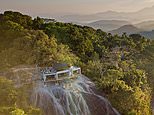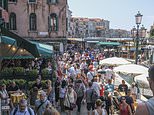
You might never have thought of going to Sri Lanka for bird-watching, but it’s always a good idea to heed the advice of the locals – even the ancient ones.
About 5,000 years ago, at what is now Kurullangala Prehistoric Cave Art Site, an unknown artist sketched the native peacocks. The depictions are so accurate it’s clear that bird-watching on this Indian Ocean island has been fashionable for a long time.
And the peacocks are still there. Their insistent crowing, forever recalling an urgent announcement over a public address system, is ubiquitous – I even heard them during the climb up Sigiriya rock, often referred to as the Eighth Wonder of the World.
This is the peafowl’s native domain but they still look incongruous, their plumage a touch over-elaborate, like an ill-judged costume for an awards ceremony.
But they are among the most obvious of a wondrous range of exotic birds which, if not enough to tempt you to this bucolic island in their own right, will certainly enhance your experience.
Dominic Couzens went on a bird-watching tour of Sri Lanka, checking into eco-friendly hotels and lodges between visits to rainforests and national parks. Above is Rosyth Estate House at Kegalle, near Colombo – one of the stops on his itinerary
Dominic heard the crowing of peacocks during the climb up Sigiriya rock (above), often referred to as the Eighth Wonder of the World
Sri Lanka has had its difficulties in recent years. A long civil war was followed by the Boxing Day tsunami of 2004, a terrorist attack in 2019, the Covid pandemic and a collapse of its economy in 2022. Yet despite all this, the country remains friendly, safe and optimistic, and as extraordinary for nature as it has always been. You can do the country a favour – tourists of all kinds are seriously welcome.
I visited for two weeks in June, travelling around the island with a wonderful guide, Manoj Kumara, from Jetwing Eco Holidays.
Kumana National Park is one of the best places in the world to see a wild leopard and sloth bear – but in a single day I saw more than 80 species of birds, with wonderful names such as common iora, purple sunbird, paradise flycatcher and greater racket-tailed drongo.
Showstopper: The peacock is among a ‘wondrous range of exotic birds’ native to Sri Lanka
Flights of fancy: Dominic spotted a painted stork at Wilpattu National Park
And at the end of that same day, at the luxurious Jetwing Surf Hotel, I sipped a gin and tonic as an Asian green bee-eater – a gloriously sleek aerial gymnast with impeccable supermodel make-up – kept distracting me with its insect-grabbing flypasts in the garden. If ever a bird knew it was pretty, it was this one. ‘Oh, do look at me,’ it seemed to say.
I did manage to spot a leopard, at the wilderness-type Wilpattu National Park in the north-west, but it was as sulky as a Hollywood diva on a bad day. No matter. It lurked by a lakeside stuffed with birds.
There were painted storks, blushing red and pink like overweight flamingos; black-winged stilts with Barbie-pink legs; white-bellied sea eagles; garish purple herons, and kingfishers – so many kingfishers of different hues, like a paint sampler at a DIY shop. So while the leopard watched, seated on the ground, all glory shone around.
At dinner that night, at the eco-friendly Thamaravila Resort, alfresco dining was accompanied by the calls of Jerdon’s nightjars and a warning that we might need to move out of the way of a wandering elephant.
Sri Lanka offers one thing in particular that is exceptional for a major safari destination. This was brought home to me as I was relaxing one dawn at the enchanting Rosyth Estate House at Kegalle, near Colombo. Watching and listening from the rooftop, the morning chorus was full of unique voices – the ‘tok, tok, tok’ came from the yellow-fronted barbet; the rolling screech from the Sri Lanka hanging parrot; the coos from the Sri Lanka green pigeon. None of these birds are found anywhere else in the world.
Dominic listened to the calls of Jerdon’s nightjars as he dined alfresco at the eco-friendly Thamaravila Resort (shown in the two images above)
At the Jetwing Surf Hotel, Dominic sipped on a gin and tonic in the company of an Asian green bee-eater bird (pictured, stock photo)
At the Wilpattu National Park, Dominic spied ‘so many kingfishers of different hues’. Above is a white-throated kingfisher in the park
In all, there are 33 bird species unique to Sri Lanka. If you want to see all of them, there is one place to go: Sinharaja Rainforest in the south. This Unesco World Heritage site is a treasure trove (even the poisonous snakes are unique, making for a potentially impressive epitaph) that’s filled with huge flocks of birds that are among the largest and most varied in the world.
Here you will find the garrulous Sri Lanka drongo, which can imitate all the other birds, and the gaudy Sri Lanka magpie that is making a pitch to turn its kin lovable with its opulent blue, brown and red livery.
I stay at Martin’s Lodge, snuggled into dense forest, and the magpie visits the porch for food, along with the Sri Lanka grey hornbill. With a good guide you can even find the serendib scops owl, which was only discovered in 2001.
An exclusive extra group is found in the Central Highlands, which includes the thrillingly rare Sri Lanka whistling thrush and the Sri Lanka woodpigeon. The latter, more attractive than it sounds, ran us a merry dance at Horton Plains National Park, where we had a very close encounter with a leopard. ‘I might die for a whistling thrush,’ I thought, ‘but not for a pigeon.’
As Dominic was relaxing one dawn at the enchanting Rosyth Estate House (above), he heard a morning chorus that was ‘full of unique voices’ – including the rolling screech from the Sri Lanka hanging parrot
‘In all, there are 33 bird species unique to Sri Lanka. If you want to see all of them, there is one place to go: Sinharaja Rainforest (above) in the south,’ writes Dominic
Kumana National Park is one of the best places in the world to see a wild leopard (right) and sloth bear (left), reveals Dominic
TRAVEL FACTS
Dominic Couzens travelled with Jetwing Eco Holidays. A bird-watching package of 14 nights, staying at seven hotels and lodges around the island, costs £2,900pp based on two sharing with nine days on a half-board basis (jetwingeco.com). Return flights with Sri Lankan Airways in October cost from £800 (srilankan.com).
All the best trips encompass some jeopardy, of course (and not just leopardy-jeopardy). In Sinharaja you run the gauntlet of leeches showing intense but unrequited desire, so don’t forget your leech socks. This is a fabulous, if rustic location, a place for people who must really want to see birds.
I also never expected to find myself stuck on a boat in a thunderstorm. The only wildlife-themed, non-marine boat trip on the island can be taken on Gal Oya National Park, in the centre of the island.
This is one of the few places in the world where visitors regularly see Asian elephants swim, from island to island, and it also hosts a substantial colony of waterbirds. During my visit the clouds built up, the rain came down in torrents and the elephants ran into the forest for cover.
Sri Lanka is beautiful, but not all of it is charmed. The local rooster, the Sri Lankan junglefowl, crows with discordant relish, a hideous noise that grates and clangs around the island. We can thank our lucky stars that it was the continental rooster, the red junglefowl, that became the world’s early morning alarm clock, and not this talentless no-hoper.
Source link
CHECK OUT: Top Travel Destinations
READ MORE: Travel News



